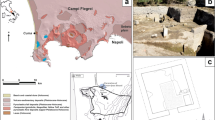Abstract
The monastery of Mileseva is one of the most important Serbian spiritual centers, and being a Romanesque type building, is nowadays mainly known for its frescoes. The first group of frescoes were produced in the 1230s. In the second half of the sixteenth century, the church was repainted with a new layer of frescoes of which only fragments have survived. These frescoes were damaged in a fire, but they happened to save (acting as a protective layer) the earlier and more valuable paintings from the thirteenth century. The fresco examined in the present study is in the southern part of the area under the dome and belongs to the XIII century fresco. The materials and techniques used for church iconography were determined by means of several micro-analytical techniques. The strong presence of the characteristic peaks of calcite (1407, 872 cm-1), in all FTIR spectra obtained from the substrate, as well as from painted layers confirms the use of the fresco technique for the construction of the wall painting. The combination of FTIR micro-spectroscopy and SEM-EDS elemental microanalysis revealed the existence of lapis lazuli in blue colours and green earth (celadonite) in green colours. In a sample taken from an angel halo, three different layers were found. With SEM-EDS elemental microanalysis it was verified that the first is a metallic layer of thickness 10–12 μm containing pure silver, while the third (2–3 μm) is gold. As was found by FTIR spectra animal glue was used to stick gold on the silver surface. The method of occurrence of the first and thicker silver sheets is still a puzzle, and we believe that it was applied from the beginning in the hagiography and then covered by the gold sheet for aesthetic reasons.
Similar content being viewed by others
References
M.R. Derrick, D. Stulik, J.M. Landry, In: Infrared Spectroscopy in Conservation Science: Scientific Tools for Conservation (The Getty Conservation Inst., Los Angeles, 1999) p. 183
A. Amold, K. Zehnder: Monitoring wall paintings affected by soluble salts. The conservation of wall paintings. Proc. Symp. organized by the Courtauld Inst. of Art and the Getty Conservation Inst., London, July 13–16, 1987 (Getty Conservation Inst., Marina del Rey, 1991) pp. 103–135
C. Selwitz, E. Doehne, J. Cult. Herit. 3, 205 (2002)
R.J.H. Clark, T.J. Dines, M. Kurmoo, Inorg. Chem. 22, 2766 (1983)
S. Bruni, F. Cariati, F. Casadio, L. Toniolo, Spectrochemical characterization by micro-FTIR spectroscopy of blue pigments in different polychrome works of art, Vibrational Spectroscopy 20 (1999) pp. 15–25
R. Ashok, In: Artists Pigments: A Handbook of Their History and Characteristics (Oxford Univ. Press, Cambridge, 1986)
Y. Chryssoulakis, S. Daniilia, The contribution of modern technologies to the true interpenetration of the inner spiritual meaning expressed through Byzantine iconography. Conf. organized by Balkan Solid State Phys. Inst., Phys. in Culture I. Thessaloniki, Greece, 28–30 October (2001) pp. 91–118
R. Feller, In: Artists Pigments: A Handbook of Their History and Characteristics, Vol. 1 (Oxford Univ. Press, Cambridge, 1985)
V. Ganitis, E. Pavlidou, F. Zorba, K.M. Paraskevopoulos, D. Bikiaris, J. Cult. Herit. 5, 349 (2004)
Author information
Authors and Affiliations
Corresponding author
Additional information
PACS
33.20.Ea; 68.37.Hk
Rights and permissions
About this article
Cite this article
Zorba, T., Pavlidou, E., Stanojlovic, M. et al. Technique and palette of XIIIth century painting in the monastery of Mileseva. Appl. Phys. A 83, 719–725 (2006). https://doi.org/10.1007/s00339-006-3548-6
Received:
Accepted:
Published:
Issue Date:
DOI: https://doi.org/10.1007/s00339-006-3548-6




